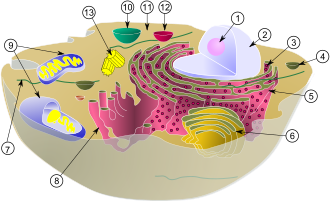Lysosomes
Lysosomes are spherical membrane-bound organelles found in many eukaryotic organisms.
They contain over 50 types of enzymes (acid hydrolases) used to break down extra- and intracellular material - carbohydrates, proteins, lipids, and nucleic acids. The internal pH (5.0–6.0) is maintained by a proton pump in the lysosome membrane. They are usually formed by separation from the smooth endoplasmic reticulum or Golgi apparatus.
We distinguish lysosomes:
- Primary – sacs with enzymes, without substrate
- Secondary – significantly larger, formed by fusion of the primary lysosome with the phagosome;
- Tertiary – contain residues of material that can no longer be broken down, such as lipofuscin.
The cell uses autophagy to recycle its own worn structures.
Diseases due to lysosomal defects:
Congenital - genetic disorders of their enzymes or regulatory proteins, there is a gradual accumulation of material, especially in the CNS and macrophages. About 40 diseases with a frequency of 1 / 100,000 births. These are mostly incurable.
- Fabry disease – this is treatable by administration of the missing α-galactosidase
- Niemann-Pick disease
- Tay-Sachs disease
- Gaucher's disease
- Pompe disease
Acquired - mostly only relative disorders due to an excess of ingested material, often in macrophages, e.g., foamy cells in atherosclerosis, but hepatocytes and the epithelium of proximal renal tubule of the kidneys can also be affected. The membranes of lysosomes can be disrupted by ingested uric acid crystals in gout for example, which leads to the release of enzymes, which is manifested by a joint inflammatory reaction.
Links[edit | edit source]
Related articles[edit | edit source]
- Lysosomal diseases
- Post-translational modifications and protein targeting
- Protein degradation
- Cell degradation system
External links[edit | edit source]
References[edit | edit source]
- LANGMEIER, Miloš, et al. Základy lékařské fyziologie. 1. vydání. Praha : Grada Publishing, a.s, 2009. 320 s. ISBN 978-80-247-2526-0.
- FUCHS, O a R NEUWIRTOVÁ. Ubikvitiny, proteazomy, sumoylace a použití dnes a zítra v terapii nádorů i jiných chorob I. Ubikvitin−proteazomový systém a transkripční faktor NF−κB [online]. ©2006. [cit. 5. 12. 2009]. <http://www.vnitrnilekarstvi.eu/pdf/vl_06_06_44.pdf>.

